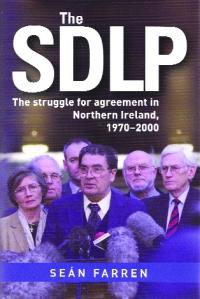The SDLP: the struggle for agreement in Northern Ireland, 1970–2000
Published in 20th-century / Contemporary History, Book Reviews, General, Issue 3 (May/June 2011), Reviews, Volume 19
The SDLP: the struggle for agreement in Northern Ireland, 1970–2000
Seán Farren
(Four Courts Press, Ä39.95)
ISBN 9781846822384
Following the launch of this book in Dublin, a senior SDLP member advised the current reviewer that this would not be an easy read. What he meant was that it contained a lot of factual information that needed to be carefully deliberated on as the book was being read. The blurb on the back cover declares that this is the first in-depth study of the SDLP’s role in the peace process. Having searched in vain for a reference to Gerard Murray’s John Hume and the SDLP in the bibliography, I am left wondering what Farren thought of Murray’s research, which was well received when that book was published in 1998. That said, the current author has succeeded in making an extremely complex period in recent Irish history accessible to the general reader by presenting us with a series of carefully constructed chapters that explain the party’s development in the context of what was happening in Northern Ireland during the years under investigation. This should be qualified by adding that Farren is a former party chairman and minister in the 1999–2002 power-sharing executive.A central motif running through the book is the SDLP’s insistence that three sets of relationships need to be taken into account when seeking agreement in Northern Ireland. First, the two communities in the North need to have their respective concerns addressed in such a manner as to break down the mental barriers that prevent the establishment of a political settlement acceptable to both. Second, North–South relations must be considered. Finally, British–Irish relations must be looked at. Amid all the violent turmoil of the years between the party’s foundation and the sharing of political office with the Ulster Unionist Party, which began in December 1999 only to be suspended ten weeks later and reinstated in May 2000, this tripartite set of relationships informed SDLP thinking and ensured that the party’s energies would be carefully directed towards seeking a comprehensive solution to the unnecessary conflict that claimed so many lives. Indeed, it is impressive to learn that when a compendium of policies was circulated among those members present at the 22nd annual conference, it contained a list of 123 significant policy initiatives, which are not, unfortunately, detailed in full in the book.A key feature of any party is its financial structure. This is discussed briefly in the chapter on the Brooke–Mayhew talks. As party membership figures were nowhere near as impressive as the SDLP’s electoral success during this period would suggest, this was a source of considerable concern. The author mentions that a Dublin support group ‘provided significant funding and at each annual conference the group presented the party with the proceeds of its efforts over the previous twelve months’. Unfortunately, nothing more is revealed about this group’s activities, which clearly invites further study. Another important point about this book is how it shows the importance of the choice of words when one is seeking to influence distrustful people to enter into dialogue with each other. Although, as one reviewer has pointed out, this book is more about policies than personalities, the figure of John Hume looms large. One cannot help but admire the tenacity of the man in seeking a peaceful settlement even at the expense of his own reputation. It is strange indeed to read the future Nobel Peace Prize winner described by Eamon Dunphy as a ‘political bomber flying over unionist heads trying to kill them’ when he was involved in talks with Gerry Adams in 1993. Garret Fitzgerald took the opposite view, writing at the time that
‘those who criticise such initiatives must surely ask themselves: if they were in a similar position to John Hume, and if they had been given by other people of good will and rational judgment reason to believe that such a contact might, even by remote chance, advance peace in Northern Ireland, could they justify to their own consciences taking the easy way out by refusing these risks?’
Ironically, Sinn Féin would later be described as ‘stealing the SDLP’s clothes’ by David McKittrick during the 1997 general election when the party spoke of partnership between nationalists and unionists and belatedly recognised the importance of unionist consent in any new political arrangement. The Good Friday Agreement of 1998, paving the way for the power-sharing executive set up in December 1999, was memorably described by Seamus Mallon as ‘Sunningdale for slow learners’, a reference to the 1973 power-sharing deal that collapsed less than a year later. Farren’s painstaking account of the long years of intellectual and violent struggle between the two executives deserves a wide audience. HI
Frank Bouchier-Hayes is a librarian and freelance writer/researcher.
















